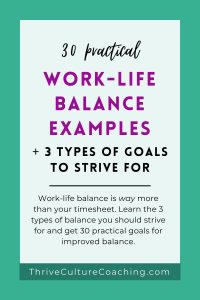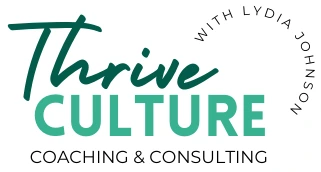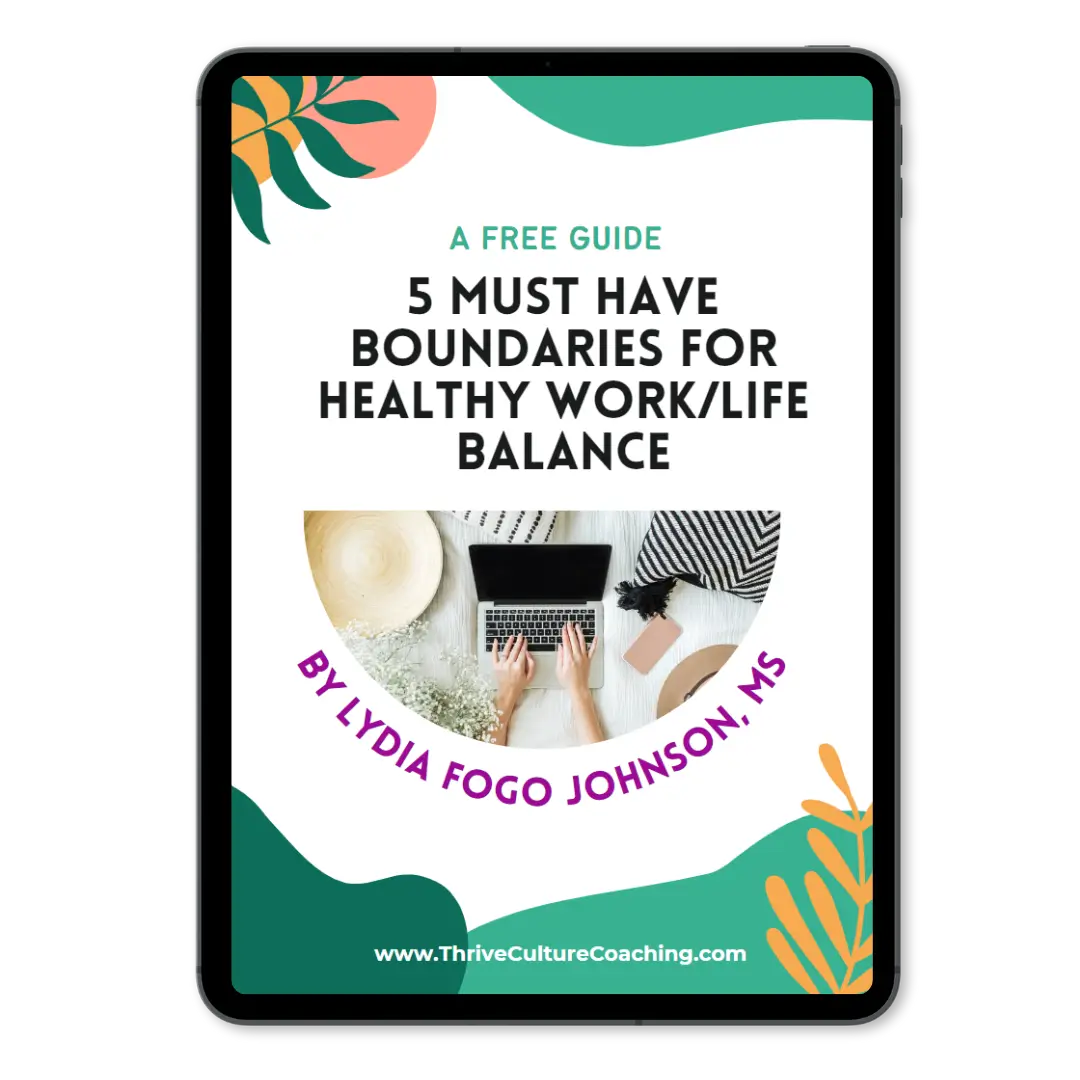Table of Contents

Photo by Lukas Blazek on Unsplash
In my former corporate consulting job, nothing made me angrier than the fact that I could not submit a timesheet for less than 40 hours. I could’ve worked overtime for months, but if I tried to submit a timesheet for 39.2 hours, it was a no-go—the submit button was grayed out. Work-life balance can feel like a squishy, never-reachable promise, but the lack of balance is often as obvious as a wrecking ball swinging toward your precarious career satisfaction and mental well-being. It’s hard to take action towards something that feels untrackable, so I’ve pulled together a list of thirty practical work-life balance goal examples you can strive towards.
Three Types of Work-Life Balance Goals to Set
Unfortunately, despite all the talk about healthy boundaries and balance between your career and your life, we tend to miss the mark of what work-life balance (WLB) really is. Even the Cambridge dictionary’s definition is overly simplistic, simply defining WLB as “the amount of time you spend doing your job compared with the amount of time you spend with your family and doing things you enjoy.” But, if you’ve ever burned out at a job, you know that work-life balance is much more complex than how much time you spend sitting at your desk vs. hanging out with your family.
In the real world, balance isn’t about clocking exactly “equal” amounts of time at work and in life, but instead, the ability to enjoy each part of your life with intentional care, attention, and engagement without one role becoming the sacrificial lamb to another. As any parent knows, true care and attention require much more than just time, so it shouldn’t really be a surprise that research shows work-life balance includes three separate components worth striving towards:
- Time: The traditional marker of balance, examining how much time we spend at work vs. elsewhere.
- Involvement: Your level of emotional and psychological involvement– does your career everything you have to give and leave crumbs for your life (or visa versa)?
- Satisfaction: The degree to which you feel satisfied and fulfilled with your different roles.
When you realize involvement and satisfaction also have to be balanced, it’s easy to understand why so many people burnout even if they’re not clocking tons of overtime. Instead of simply a time imbalance, most of my career coaching clients are experiencing an imbalance of involvement and satisfaction. This might be what you’re experiencing if you ever feel like…
- Your general life fulfillment is slowly poisoned by the slow creep of your work-related disappear.
- You can never psychologically detach enough from work stress to invest energy and care into your personal life and family.
- Even if you’re not constantly at your desk, you’re continually working in their minds, leaving you with nothing left for your family and yourself.
If you’re ready to find a more equal and sustainable way to juggle your work and your family life, I’ve created a list of thirty practical work-life balance goals to help guide your way.

Photo by Piret Ilver on Unsplash
30 Work-Life Balance Goal Examples
Balancing Your Time
- Take your birthday and your spouse’s birthday off work. You’re welcome for the improvement in your marriage!
- Set defined work hours: Have a clear-cut “end of work time” and give yourself a 30-minute, meeting-free buffer before the cut-off to wrap up your to-dos.
- Schedule a “me day” at least once a quarter where you avoid doing anything productive and just enjoy the hell out of it.
- Next time you have a doctor’s appointment or errand, take off a few more hours than you need. Why rush back?
- Actually take sick days when you’re sick. If you must work (really?? You HAVE to??), take a sick day when you’re better.
- Take a day off for a quarterly meeting with your spouse, where you have an “off-site family leadership meeting” to cover all the big topics: life planning, logistics, budgeting concerns, etc. Oh, and don’t forget to drink mimosas with brunch before you dive in.
- Use all your damn vacation days—4 in 10 Americans don’t. Don’t be like most Americans.
- Block your calendar for lunch breaks and walk away from your desk to eat. A short break and more mindful eating are good for your brain, productivity, and waistline!
- Block off time for deep work, such as a few hours a day or a full day once a week so that you can avoid the “meetings all day but no actual work done” phenomenon. Author Greg McKeown suggests blocking several 30-minute “appointments” during your day as a buffer zone for deep focus or overflow tasks.
- Set up recurring out-of-office events that auto-decline meetings outside of your availability. Make technology do the dirty work for you.
Balancing Your Involvement
- Strive to mentally clock out of work and stay more engaged in the present moment with practices like mindfulness and labeling.
- Take multiple “micro” breaks throughout the day to help you reserve more mental capacity and energy for your personal time. Research shows even micro-breaks of just a few minutes can help increase energy, reduce fatigue, and increase performance on some tasks.
- Mindfully transition from one hat to another by taking a few extra minutes to clear your head and center yourself. Creating a short routine or ritual, such as sitting in a specific chair for a 5-minute meditation or listening to a favorite song, can help your brain switch gears and avoid “spillover,” when stress from one area of life follows you into another.
- Try to limit the number of times you have to switch into your personal hat during your workday. For example, at work, check your personal phone at specific times (make sure people know how to reach you, like via a call, in case of an emergency).
- Limit technology-based work interruptions during your personal life by installing app blockers (I like App Block and Stay Free), deleting work-related apps off your personal phone, or leaving your phone in another room.
- Learn strategies to help you stay motivated and focused at work so you don’t exert all of your willpower during your workdays. If you have ADHD, I highly recommend the book Extra Focus (but it’s great for all humans because we all could use more coping skills).
- Schedule a weekly me-night to ensure you have time to recuperate your energy and practice self-care.
- At least once a year, reassess your career goals and consider if any changes are needed. This is a good time to casually explore job postings—remembering there truly are other jobs out there can help reduce the stress of feeling trapped.
- Limit work-related talk with your spouse and friends to specific times so you can discuss other important topics and connect personally. For example, during date nights, my husband and I only talk about work until the food comes.
- If you work from home, separate your work and life by only working in a specific area of the house (and never your bedroom) to help you avoid accidentally slipping into work-mode when you’re supposed to be in family-mode.
Balancing Your Satisfaction
-
- Set short-term and long-term personal goals as well as professional goals. You’re more than just your career, so let’s plan like it, eh?
- Learn things just for fun that aren’t related to your career goals. Hobbies are cool AND good at reducing burnout.
- Prioritize your personal passions and self-care by dedicating time each week to take off the hats of partner, professional, and parent and just be yourself.
- Strive to have at least one project at work that aligns with your passions, talents, or personal identity. For example, join an employee resource group related to your identity (e.g., parenthood, LGBTQ+) or pitch a project that lets you leverage your signature skill. Bonus points for getting rid of a project you hate to make room for this!
- Create a nightly habit of gratitude journaling (or an ongoing habit of savoring) to get the most satisfaction possible from what’s going well in your personal and professional life.
- Discover and reflect on your personal values and strive to realign your life and career with these values. Use them to measure your “success” so you can decouple your self-worth from career accomplishments.
- If you enjoy reading, set a goal to read a certain number of “for fun” books so you’re not only reading work or personal-development related materials.
- At least once a quarter, set aside time to reflect on every area of your life and create an action plan for anything that needs improvement. I highly suggest using a Wheel of Life or similar tool—it’ll help you take a holistic view.
- Strive to have something on your calendar every week that you’re looking forward to, whether it’s at work or at home.
- Find small ways to use your signature strengths and skills more often at work and at home. It’ll help you feel like your time is more aligned with who you really are and what you love.
Work-Life Balance Goals: The Bigger Picture
As you can see, balancing work and family isn’t about obsessing over the clock. Instead, it’s about carefully adjusting the inputs of your time, energy, and attention to maximize the outputs— the ability to enjoy a thriving, fulfilling career and personal life. Creating a healthy balance is a never-ending, daily practice of making intentional choices that nourish you both personally and professionally. While these steps may seem small, how you spend your time, energy, and attention each day adds to how you have spent your life.
My biggest hope is that at the end of your one precious life, you’ll lean your aching body back into your rocking chair and feel satisfied that you took the initiative to focus on what truly matters to you. Whether you use one of these examples or something else, I hope you’ll pick a few small changes to start rebalancing your work and life today… so you can thrive in all of your tomorrows a little bit more.
(PS- If you’re reading this list and feel all these are impossible, let’s talk. I’ve worked with dozens of clients, many balancing leadership positions with raising young kids, who felt exactly the same way before we started working together. If you’re ready to create more work-life balance, let’s discuss your situation to see if holistic career and burnout coaching can help you start thriving at work AND at home).
Save these Work-Life Balance Goals for Later with a Pin…

30 Practical Work-Life Balance Examples




Share